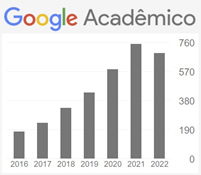A trajetória das divisões pesadas da URSS e Rússia e dos EUA ao início e ao final da Guerra Fria
DOI:
https://doi.org/10.5965/2175180313322021e0106Resumo
Este artigo apresenta e discute o trajeto que levou os desenhos organizacionais das divisões pesadas da URSS e dos EUA ao início e ao final da Guerra Fria. Para tanto, explica as armas combinadas modernas centradas no tanque e o papel central do escalão de comando divisão (10.000-20.000 combatentes) para a disponibilização dos diferentes tipos de tropas necessários para que se possa tê-las quando necessário. Apresenta então os corpos de tanques e mecanizados da URSS, e a divisão blindada dos EUA em 1945, delineando como se chegou às divisões de rifles motorizados e de tanques da URSS e às divisões blindadas e mecanizadas dos EUA tomando c. 1985 como proxy para 1991 em função da turbulência do final da Guerra Fria. A conclusão afirma a continuidade e prevalência do enquadramento de disponibilização de armas combinadas modernas centradas no tanque na divisão como consideração principal no desenho organizacional de forças terrestres até o presente.
Downloads
Referências
ALLEN, Matthew. Military helicopter doctrines of the major powers, 1945-1992. Westport: Greenwood Press, 1993.
ATKINSON, Rick. An army at dawn: the war in North Africa, 1942-1943. New York: Henry Holt and Co., 2002.
BAILEY, Jonathan B. A. Field artillery and firepower. Annapolis: US Naval Institute Press, 2003.
BAXTER, William P. Soviet airland battle tactics. Novato: Presidio Pr., 1986.
BELLAMY, Chris. Absolute war: Soviet Russia in the Second World War. Vancouver: Vintage, 2008.
BELLAMY, Chris. The evolution of modern land warfare: theory and practice. London: Routledge, 2015.
BOYNE, Walter J. How the helicopter changed modern warfare. Gretna: Pelican Publishing, 2011.
BROWN, John Sloan. Kevlar legions: the transformation of the U.S. Army, 1989–2005. Washington: Center of Military History, 2011.
CANCIAN, Mark F. US military forces in FY 2021: army. Washington: CSIS, 2020.
COAKLEY, Robert W; LEIGHTON, Richard M. Global logistics and strategy, 1943-1945. Washington: Office of the Chief of Military History: United States Army, 1968.
COCKBURN, Andrew. The threat: inside the Soviet military machine. London: Random House, 1983.
CORDESMAN, Anthony H; WAGNER, Abraham. The lessons of modern war: the Gulf War. Boulder: Westview, 1996.
CRANE, Keith; OLIKER, Olga; NICHIPORUK, Brian. Trends in Russia’s armed forces: an overview of budgets and capabilities. Santa Monica: RAND, 2019.
CSI. Combat Studies Institute. Sixty years of reorganizing for combat: a historical trend analysis. Fort Leavenworth: Combat Studies Institute, 1999.
DAVIES, R. Mark et al. USA 1980s TO&Es: v 2.7. Ocean Isle Beach: Fire and Fury Games, 2019.
DEIGHTON, Len. Blitzkrieg: from the rise of Hitler to the fall of Dunkirk. [S.l.]: Castle, 2000.
DELBRÜCK, Hans. The dawn of modern warfare: history of the art of war. Lincoln: University of Nebraska Press, 1990. v. 1.
DUNNIGAN, James F. Organization of Soviet Ground Forces. In: STAFF, S.; STAFF, T. (eds.). The war in the East. New York: SPI, 1977. p. 105-125.
DUNNIGAN, James F.; MACEDONIA, Raymond M. Getting it right: American military reforms after Vietnam to the Gulf War and beyond. 2. ed. New York: William Morrow & Co, 2001.
DUPUY, Trevor Nevitt. The evolution of weapons and warfare. Boston: Da Capo Press., 1990.
EDGERTON, David. Britain's war machine: weapons, resources and experts in the Second World War. London: Allen Lane, 2011.
ELLIS, John. The World War II databook: the essential facts and figures for all the combatants. London: Aurum Press, 1993.
ENGLISH, John A.; GUDMUNDSSON, Bruce I. On infantry. 2. ed. Westport: Praeger, 1994.
ERICKSON, John; HANSEN, Lynn; SCHNEIDER, William P. Soviet ground forces: an operational assessment. London: Routledge, 2019.
EVANS, Michael. General Monash's orchestra: reaffirming combined arms warfare. In: EVANS, Michael; RYAN, Alan. From Breitenfeld to Baghdad: perspectives on combined arms warfare. Duntroon: Land Warfare Studies Centre, 2003. p. 1-26.
FLANAGAN, Stephen J. et al. Deterring Russian aggression in the Baltic States through resilience and resistance. Santa Monica: Rand, 2019.
FRIEDMAN, Norman. The Fifty-Year War: conflict and strategy in the Cold War. Annapolis: Naval Institute Press, 2007.
GALEOTTI, Mark. The modern Russian army 1992–2016. Oxford: Osprey, 2017.
GILLIE, Mildred Hanson. Forging the thunderbolt: a history of the development of the armored force. Washington: Military Service Publishing, 1947.
GLANTZ, David M. Soviet Force Structure in an Era of Reform. The Journal of Soviet Military Studies, [S.l.], v. 2, n. 3, p. 361-93, 1989.
GLANTZ, David M. Soviet military operational art: in pursuit of deep battle. London: Frank Cass, 1991a.
GLANTZ, David M. The Soviet conduct of tactical maneuver: spearhead of the offensive. London: Routledge, 1991b.
GLANTZ, David M. The military strategy of the Soviet Union: a history. London: Routledge, 2001.
GLANTZ, David M. The Soviet strategic offensive in Manchuria, 1945: August Storm. London: Routledge, 2003.
GLANTZ, David M. The Development of the Soviet and Russian Armies in Context, 1946–2008: A Chronological and Topical Outline. The Journal of Slavic Military Studies, [S.l.], v. 23, n 1, pp. 27–235, 2010.
GLANTZ, David M et al. Slaughterhouse: the handbook of the Eastern front. Bedford: The Aberjona Press, 2004.
GLANTZ, David M.; HOUSE, Jonathan M. When titans clashed: how the red army stopped Hitler, revised and expanded edition. Lawrence: University Press of Kansas, 2015.
GREENFIELD, Kent; PALMER. Robert R; WILEY, Bell I. The army ground forces: the organization of ground combat troops. Washington: Center of Military History, 1987.
GROPMAN, Alan. Introduction. In: GROPMAN, Alan (ed.). The big “L”: American logistics in World War II. Washington: GPO, 1997. p. ix-xii.
GUDMUNDSSON, Bruce I. On artillery. Westport: Praeger, 1993.
GUDMUNDSSON, Bruce I. On armor. Westport: Praeger, 2004.
GUNSTON, Bill. Modern fighting helicopters. London: Salamander, 1999.
HANSON, Philip. The rise and fall of the Soviet economy: an economic history of the USSR 1945-1991. London: Pearson Education Limited, 2003.
HAWKINS, Glen R. US army force structure and force design initiatives 1939-1989. Washington: US Center for Military History, 2013.
HAWKINS, Glen R.; CARAFINO, Jay. Prelude to army XXI: U.S. army division design initiatives and experiments, 1917-1995. Washington: Center of Military History, 1997.
HAYTHORNTHWAITE, Phillip J. The napoleonic sourcebook. London: Arms and Armour Press, 1997.
HERBERT, Paul H. Deciding what has to be done: General William E. DePuy and the 1976 edition of FM 100-5, operations. Fort Leavenworth: Combat Studies Institute, 1988.
HOUSE, Jonathan M. Toward combined arms warfare: a survey of 20th-Century tactics, doctrine, and organization. Honolulu: University Press of the Pacific, 2002.
HOUSE, Jonathan M. A military history of the Cold War, 1962–1991. Norman: University of Oklahoma Press, 2020.
IISS. The International Institute for Strategic Studies. The military balance 2016. London: Routledge, 2016.
ISBY, David C. Weapons and tactics of the Soviet army. London: Jane's, 1988.
JARYMOWYCZ, Roman. Tank tactics: from Normandy to Lorraine. Mechanicsburg: Stackpole, 2008.
JORDAN, David et al. Understanding modern warfare. 2. ed. Cambridge: Cambridge University Press, 2016.
KEDZIOR, Richard W. Evolution and endurance: the U.S. army division in the 20th Century. Santa Monica: Rand Publishing, 2000.
LEIGHTON, Richard M.; COAKLEY, Robert W. Global logistics and strategy, 1940-1943. Washington: Office of Chief of Military History, 1955.
MCCONVILLE, James C. Army multi-domain transformation. Washington: Headquarters: Department of the Army, 2021. (Chief of Staff Paper #1).
MACGREGOR, Douglas A. Breaking the phalanx: a new design for landpower in the 21st Century. 3. ed. Westport: Praeger, 1997.
MACGREGOR, Douglas A. Transformation under fire: revolutionizing how America fights. Westport: Praeger, 2003.
MANDELES, Mark. The future of war: organizations as weapons. Washington: Potomac Books, 2005.
MARTYANOV, Andrei. Losing military supremacy: the myopia of American strategic planning. Atlanta: Clarity, 2018.
MCGOWEN, Stanley S. Helicopters: an illustrated history of their impact. Santa Barbara: ABC-CLIO, 2005.
MILLER, Christopher F. Modern land combat. London: Salamander, 2001.
O’HANLON, Michael E. The science of War: defense budgeting, military technology, logistics, and combat outcomes. Princeton: Princeton University Press, 2009.
OHL, John Kennedy. Supplying the troops: General Somervell and American logistics in World War II. Ithaca: Cornell University Press, 2020. E-book.
REESE, Roger R. The Soviet military experience: a history of the Soviet army, 1917-1991. London: Routledge, 2000.
RENZ, Bettina. Russia’s military revival. Cambridge: Polity, 2018. E-book.
ROMJUE, John. From active defense to airland battle: Development of Army Doctrine 1973-1982. Fort Monroe: TRADOC, 1985.
ROMJUE, John. The army of excellence: the development of the 1980s army. Ft. Monroe, VA: TRADOC, 1997.
ROTTMAN, Gordon L. Inside the US army. Oxford: Osprey, 1988.
ROTTMAN, Gordon L. World War II combat reconnaissance tactics. Oxford: Osprey, 2007.
ROTTMAN, Gordon L. World War II infantry assault tactics. Oxford: Osprey, 2008.
ROTTMAN, Gordon L. World War II US armored infantry tactics. Oxford: Osprey, 2011.
SKINNER, Michael. USAREUR: the United States army in Europe. Novato: Presidio, 1989.
STEWART, Richard W. American military history volume 2: the United States army in a global era, 1917-2010. 2. ed. Alexandria: St John’s Press, 2010.
SUTYAGIN, Igor; BRONK, Justin. Russia’s new ground forces. Abingdon: Routledge, 2017.
US ARMY. FM 100-5 operations. Washington: GPO, 1976.
US ARMY. FM 100-2-1 the Soviet Army, operations and tactics. Washington: GPO, 1984.
US ARMY. FM 100-2-3 the Soviet army: troops, organization and equipment. Washington: GPO, 1991.
TUCK, Christopher. Understanding land warfare. Abingdon: Routledge, 2014.
VVAA. Soviet TO&Es 1980-1989: v 1.9. Ocean Isle Beach: Fire and Fury Games, 2011.
WILSON, John H. Maneuver and firepower: the evolution of divisions and separate brigades. Washington: Center of Military History: US Army, 1998.
ZALOGA, Steven J. Tank war-central front. Oxford: Osprey Publishing, 1989.
ZALOGA, Steven J. US armored divisions: the European theater of operations, 1944–45. Oxford: Osprey Publishing, 2004.
ZALOGA, Steven J. US armored units in the North Africa and Italian campaigns 1942-45. Oxford: Osprey Publishing, 2006.
ZALOGA, Steven J. US field artillery of World War II. Oxford: Osprey Publishing, 2011.
ZALOGA, Steven J; NESS, Leland S. The red army handbook, 1939-1945. Stroud: Sutton Publishing, 1998.
Downloads
Publicado
Como Citar
Edição
Seção
Licença
Copyright (c) 2021 Revista Tempo e Argumento

Este trabalho está licenciado sob uma licença Creative Commons Attribution-NonCommercial 4.0 International License.
Os artigos cujos autores são identificados representam a expressão do ponto de vista de seus autores e não a posição oficial da Tempo e Argumento.






